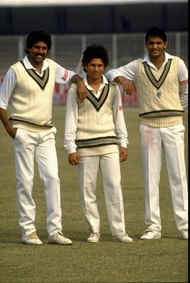In a few hours, Sachin Tendulkar will walk the last few yards of his cricketing career at Mumbai, putting the finishing touches to, unarguably, the most followed career in world cricket.
The last few years have witnessed the retirement of a golden generation of cricket’s gentlemen. The likes of Warne, Dravid, Lara, Ponting and McGrath have all hung up their shoes, and it is Tendulkar’s turn to follow suit. However, the feeling of loss that will accompany India’s second master blaster’s retirement will be much greater than that felt before. But this will not be because Sachin was a far greater cricketer than those mentioned.
Quite simply, Sachin Tendulkar’s contribution to the game was much larger than his glorious straight drive or the audacious uppercut. If anything, his single greatest gift to the spectators was that his presence on the pitch gave an emotional, rather than a logical, reason for falling in love with the game. And as always, emotion trumps logic.
AHMEDABAD, INDIA – MARCH 24: A young cricket fan shows his support to Sachin Tendulkar of India during the 2011 ICC World Cup Quarter Final match between Australia and India.
A lot has been said and written about Tendulkar’s cricketing ability. For close to a decade, millions have debated over whether he is the finest batsman of all time. Test averages be damned, people have argued. Longevity backed by sustained excellence in performance is what matters.
But none of the above can quite explain the godlike status enjoyed by Tendulkar.
Sachin’s debut as a 16-year old in Pakistan was what , undoubtedly, placed him on the pedestal in the populace’s heart.
The India of the late 1980s and early 1990s was a turbulent one. The rapid opening of the economy due to balance of payments crisis coupled with the decline in the Indian hockey team presented a fertile and ripe time for planting the Tendulkar sapling. While the former brought the medium of television to the general public, the latter provided a space for another sport.
Though India had gained success in the early and mid-1980s in One Day Internationals, the national cricket team lacked a player of consistent flair and substance. Sunil Gavaskar had retired, but his abilities were more suited to the longest version of the game. Limited overs cricket was bringing a dash of the crazy-a touch of bravado-to the staid dealings associated with the game played in whites, and Indians craved for their own Viv Richards.
And so, a teenager walked onto the National Stadium green of Karachi across the border to face a battery of fast bowlers the world has not seen the likes of since. Imran Khan, Wasim Akram, and Waqar Younis formed the Pakistani pace triumvirate, and they made Tendulkar bleed for his runs. However, the chin music would not keep Tendulkar down.

Oct 1989: (L-R) Kapil Dev, Sachin Tendulkar and Mohammed Azharuddin pose for the camera before the Test series against Pakistan in India.
The image of a 16-year old declining medical assistance while blood streamed from his nose captured the nation’s imagination. That was Tendulkar displaying substance. The display of flair came in an exhibition game played at Sialkot, where legendary leg-spinner Abdul Qadir was hammered for four sixes in an over, with Tendulkar making 53 runs off just 18 balls.
But how exactly did the youngster make people swoon?
Unlike Rahul Dravid, who had hoards of women lining up to snatch at his hand given the opportunity, Sachin’s connection to the ordinary Indian has been more familial. To women, Sachin would be the younger brother. Wives and husbands would see him as a favourite nephew. Boys his age would imagine him as a brother or close friend. And he would be the older sibling to children younger than him.
And even though Sachin grew in age, the relations remained unchanged. Housewives would not stop their chores because they appreciated the technical brilliance of his cover-drive. Barbers did not stop the process of shaving because they felt that Sachin played the pull better than most. Ten-year-olds did not stop their gulli-cricket matches to watch him bat so that they could pick up batting tips.
The nation, as it has been often said, did not stop breathing to watch his cricketing excellence. The nation stopped because here was someone they felt they knew more than others, someone they had grown up with. It didn’t matter if Sachin was going through the worst form of his life. His fans would be there to watch him, not because there might be a chance of him making a hundred, but because he was like family. And there is nothing more important than family.
Sachin began his career as the quintessential underdog, standing up to fearsome fast bowlers while he was still not eligible to vote. Through the years, his progress led him to the other extreme of the spectrum: a titan of the game. Should any bowler get his wicket, he would treasure it like his own offspring, cuddled up with him in his bed. But despite his larger-than-the-game persona, the public’s love for him did not diminish. Everyone was now celebrating his successes, just as a family would when the youngest cleared an entrance examination and enrolled into a prestigious school.
Sachin’s greatness does not lie in his ability with the willow. While that may seem as an extremely controversial statement, the difficulty to detach oneself from one’s feelings while evaluating Sachin is the true obstacle. One does not, and cannot, say Sachin is inferior to another batsman. No, not in India.
There have been very few things in Sachin’s career which can be held against him. He has lived a rather clean and subdued life outside the game even in today’s privacy-free times. And maybe that has helped his standing in our minds. There is nothing like a brilliant performer who behaves with class and dignity. Virat Kohli may achieve more than Sachin in cricketing terms by the time his career ends, but he will never be loved in the same way. If Sachin was a champion, he was a good champion. And as Michael Sheen would have said-like he did in The Dammed United as Brian Clough-Kohli is not a ‘good’ champion.
However, there remains a rather strange anomaly. Sachin has always maintained that he would play as long as there is some love for the game still in him. He did give up playing international 20-20s so that younger players got an opportunity, and retired from ODIs after the 2011 World Cup triumph for the same reason-apart from the fact that he had achieved everything in the 50-over form of the game.
His extended stay in the Test format has been confounding, then. Is his love for the game running out just as his 200th Test nears? If that is the case, it is one incredible coincident. Unfortunately, there is no place for a coincident in statistics. For someone who owns pretty much every statistic in cricket-while maintaining that he has no place for them in his mind-a certain amount of curiosity remains over his Test retirement.
In India’s tour of Australia in 2003-04, a spectator held up a banner praising Sachin at Sydney: “Commit all your crimes while Sachin is batting. They will all go unnoticed as even God is watching.”
God may not be watching Sachin’s batting for his technique or the timing. If anything, He’ll be watching Tendulkar bat as a father would watch his son: with pride.
Follow IPL Auction 2025 Live Updates, News & Biddings at Sportskeeda. Get the fastest updates on Mega-Auction and cricket news

